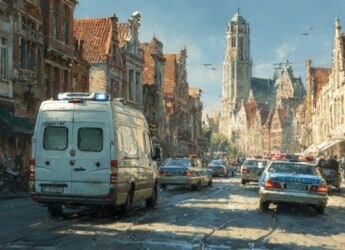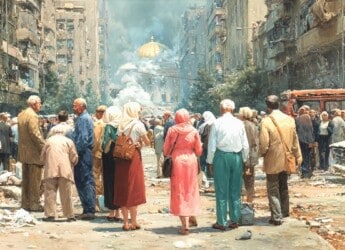|
|
Content Assessment: High Stakes on the Eastern Front: Russia's Uphill Battle in Ukraine (December 7, 2023)
Information - 92%
Insight - 90%
Relevance - 91%
Objectivity - 93%
Authority - 94%
92%
Excellent
A short percentage-based assessment of the qualitative benefit expressed as a percentage of positive reception of the recent synthesis of reporting from the Institute for the Study of War on the Russo-Ukrainian War.
Source Note: One of the most accurate and detailed sources for ongoing updates on the Ukraine crisis is the Russian Offensive Campaign Assessment from the Institute for the Study of War. The Institute for the Study of War (ISW) is a 501(c)(3) organization and produces strictly non-partisan, non-ideological, fact-based research. ISW seeks to promote an informed understanding of war and military affairs through comprehensive, independent, and accessible open-source research and analysis. ISW’s research is made available to the general public, military practitioners, policymakers, and media members. Providing a daily synthesis of key events related to the Russian aggression against Ukraine, ISW updates may benefit investigators and litigators as they follow the business, information technology, and legal trends and trajectories impacted by and stemming from the current Russo-Ukrainian conflict.
For those seeking to grasp the full scope of this evolving landscape, the complete updates from the Institute for the Study of War serve as an invaluable resource.
Russo-Ukrainian Conflict Update*
High Stakes on the Eastern Front: Russia’s Uphill Battle in Ukraine
ComplexDiscovery Staff
Nearly 22 months into its invasion of Ukraine, which began on February 24, 2022, Russia is suffering troop losses at a rate that could be difficult to sustain long-term, even as President Vladimir Putin shows willingness to continue the war despite rising domestic discontent. Ukrainian officials estimate Russia lost 11,000 soldiers in November across several fronts, with the casualties likely even higher in intense battles for the city of Bakhmut. Russia is generating 20,000 to 40,000 new recruits a month, Ukrainian sources say, meaning losses are significant compared to replacement troops.
The war is clearly attritional, with Ukraine saying it killed or wounded over 3,400 Russian soldiers in Kherson from October to November. Still, Russia seems able to absorb the losses so far with a steady stream of new recruits.
This week saw continued fighting across Ukraine as winter sets in. Russian drones struck port infrastructure in Odesa, while Ukrainian forces say they downed over a dozen drones nationwide. Battles rage near Svatove-Kreminna, Bakhmut and Avdiivka, where Russia made small gains.
Political and Economic Implications
The backdrop of the losses and continued fighting saw significant political and economic developments this week in Russia, Ukraine and the West.
The U.S. pledged another $175 million security package for Ukraine, including missiles, anti-armor weapons and ammo. The two sides also signed a statement to jointly produce weapons, allowing Ukraine to better sustain its forces.
Putin hosted Iran’s president to discuss expanding economic ties and trade. Analysts say this could help both countries blunt the impact of Western sanctions over Ukraine.
Domestically, Russia set March 2024 as the date for the next presidential election in an effort to add legitimacy amid discontent over the war’s impacts. However, independent polls show less enthusiasm for voting compared to state-run media polls.
There are also calls by nationalists to resurrect Soviet-style security agencies to hunt dissidents after recent attacks on pro-war figures in Russia itself. This week, security forces detained members of two gangs with ties to Russia’s interior ministry.
Analysts say this allows Russia to paint perceived “enemies” at home and abroad as national security threats. It also lets security agencies cement more internal control and purge dissent, they say.
The Stalemate Persists
Nearly 10 months since Russia’s last major advance by capturing Lysychansk, the inconclusive status of the war persists even as both sides take heavy losses.
Ukraine likely lacks the overwhelming force needed to retake large swaths of Russian-occupied territory, according to military observers. But Russia is also unable to capture key remaining Ukrainian-held territory in the Donbas despite its gains around Bakhmut.
Western aid and weapons continue to flow into Ukraine, allowing it to sustain resistance despite extensive damage to civilian infrastructure like water and electric facilities. There are currently no signs Putin intends to pull back from occupied zones.
Still, the Kremlin could face challenging tradeoffs if the high casualty rate limits Russia’s battlefield manpower next year. Pressure from ultra-nationalist voices at home continues for all-out efforts to make new gains in Ukraine as Russians face eroding living standards.
As of December 7, 2023, the Russian-Ukrainian conflict is marked by a complex interplay of increasing military attrition, strategic adjustments, and significant domestic and international responses. This situation continues to underscore the evolving and challenging nature of the conflict, with far-reaching implications for both regional stability and global geopolitical dynamics.
Additional Information
- Institute for the Study of War (understandingwar.org)
- Deepening Challenges for Russian Forces and Diplomatic Maneuvers in Ukraine Conflict (November 29, 2023) (complexdiscovery.com)
We do not report in detail on Russian war crimes because those activities are well-covered in Western media and do not directly affect the military operations we are assessing and forecasting. We will continue to evaluate and report on the effects of these criminal activities on the Ukrainian military and population and specifically on combat in Ukrainian urban areas. We utterly condemn these Russian violations of the laws of armed conflict, Geneva Conventions, and humanity even though we do not describe them in these reports.
Detailed Reporting with Maps for December 7, 2023, from the ISW – Mouseover to Scroll
Russian Offensive Campaign Assessment, December 7, 2023Review the Detailed Reporting and Maps PDF
About the Institute for the Study of War Research Methodology
ISW’s research methodology relies on both primary and secondary sources, enabling researchers to develop a comprehensive understanding of the situation on the ground. In order to analyze military and political developments in any given area, ISW’s research analysts must wholly understand the systems of enemy and friendly forces. They must also understand the population demographics, physical terrain, politics, and history of that area. This lays the analytical foundation for understanding the reasons for particular developments and fulfilling their assigned research objectives. ISW analysts also spend time in places like Iraq, Afghanistan, and elsewhere in order to gain a better understanding of the security and political situation and to evaluate the implementation of current strategies and policies. Our researchers compile data and analyze trends, producing a granular analysis of developments in areas of research, producing an accurate, high-resolution, timely, and thorough picture of the situation. ISW’s research methodology guarantees its success and commitment to improving the nation’s ability to execute military operations, achieve strategic objectives, and respond to emerging problems that may require the use of American military power.
About the Institute for the Study of War
The Institute for the Study of War advances an informed understanding of military affairs through reliable research, trusted analysis, and innovative education. We are committed to improving the nation’s ability to execute military operations and respond to emerging threats in order to achieve U.S. strategic objectives. ISW is a non-partisan, non-profit, public policy research organization.
Learn more, get involved, and contribute today.
Additional Reading
- From Dissent to OSINT? Understanding, Influencing, and Protecting Roles, Reputation, and Revenue
- [Annual Update] International Cyber Law in Practice: Interactive Toolkit
- Data Embassies: Sovereignty, Security, and Continuity for Nation-States
Assisted by GAI and LLM Technologies
* Sourced and shared with direct express permission from the Institute for the Study of War (ISW).
Source: ComplexDiscovery









































